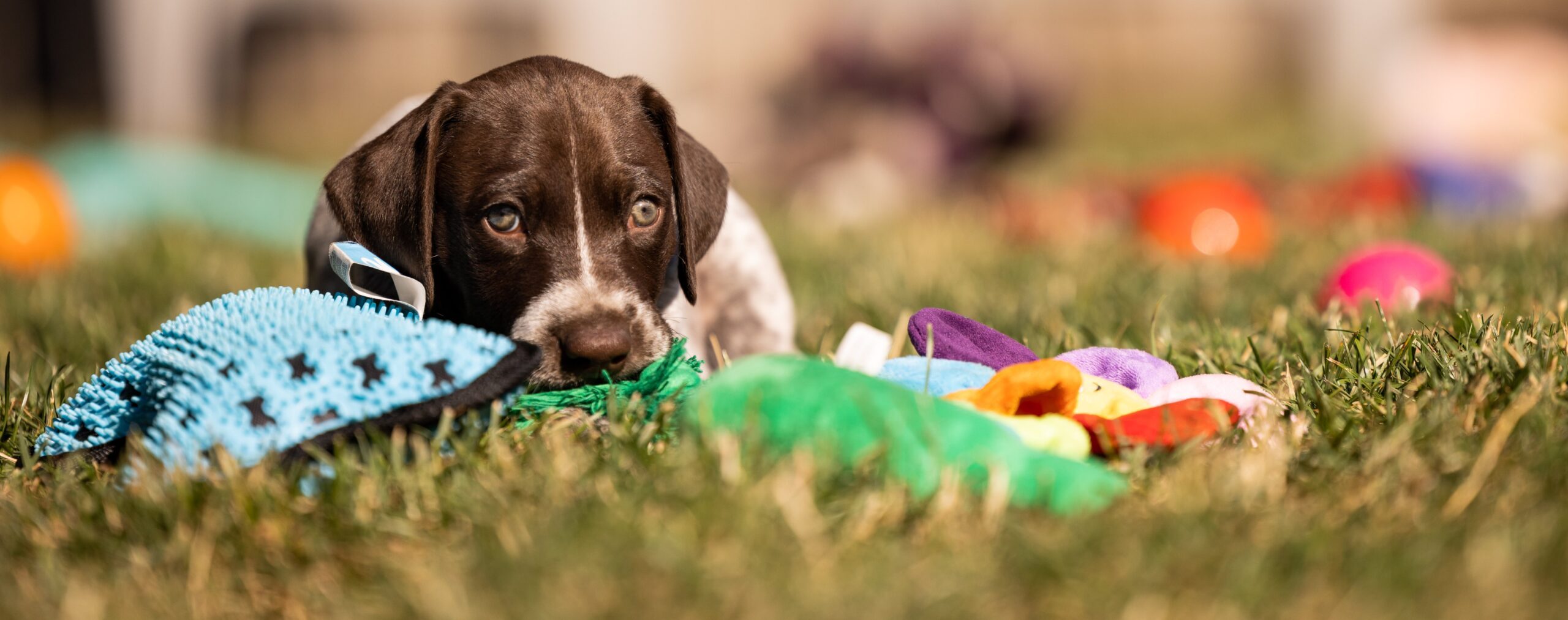Building Confidence & Preventing Anxiety in Dogs
When raising a puppy, or caring for a solo adult dog, one of the most underappreciated tools in a dog parent’s toolkit is independent play: allowing your dog to engage with toys and stimulation without your involvement. Far from being “boring alone time,” independent play builds mental resilience, self-confidence, and helps prevent separation anxiety, especially in single-dog households.
Why Independent Play Matters
- Builds Self-reliance & Confidence.
Dogs that can entertain themselves gain the mental skills to solve problems on their own, rather than relying solely on humans. That confidence translates into calmer behavior when left alone. - Separation Anxiety Prevention.
According to the AKC, one of the keys to preventing separation anxiety is teaching puppies to enjoy being alone and amuse themselves with toys. American Kennel Club
DOGG!T Behavior trainers also emphasize gradually increasing alone time using enrichment to help dogs self-soothe. - Mental Enrichment & Self-organization.
A dog that plays independently learns to pace themselves, switch between activity and rest, and regulate excitement. Over time, that leads to more predictable, balanced behavior. - Support for Single-Dog Homes.
In multi-dog homes, pups can lean on each other for stimulation. But in solo-dog homes, independence is essential. Without a built-in playmate, the dog must find ways to self-stimulate (toys, puzzles, safe chewing).
How to Encourage Healthy Independent Play
- Start Small, Safely
When you see your dog quietly engaging with a toy (e.g. a chew, puzzle), resist the urge to interrupt, if the behavior is non-destructive, let it continue. Use that moment to reinforce that independence is acceptable. - Rotate Enrichments & Puzzle Toys
Keep novelty high. Cycle in toys your pup hasn’t seen for a week. Use puzzle feeders, Kongs with hidden treats, snuffle mats, or tug-toys anchored safely. - Design a Safe Solo Zone
Create a comfy, confined “play nook” filled with safe chew toys, puzzles, and their water. That space becomes the go-to for independent play; avoid clutter or hazards. - Delayed Engagement Principle
If your pup starts independent play and you go to join or interrupt, delay your involvement. Wait until they’ve been playing calmly a bit longer before you step in. This reinforces that their own activity is valued. - Gradual Alone-Time Exposure
Practice alone time while you’re home (in another room) for short durations. Slowly extend them. Always pair with rewarding enrichment. This mirrors how separation anxiety should be trained (gradual desensitization). - Don’t Overdo It
If your dog is frustrated, chewing inappropriately, or becoming destructive, it’s a signal to scale back. The goal is confident independence, not stress.
Signs of Healthy vs. Problematic Solo Play
| Behavior | Healthy Independent Play | Problematic Behavior |
|---|---|---|
| Duration | 5–20 minutes (depending on age) | Restlessness, pacing, incessant vocalization |
| Engagement type | Chewing, rotating toys, solving puzzles | Repeated biting at doors, obsessively seeking human, destructive chewing |
| Settling | Dog alternates active play & rest | Escalating into destructive or anxious behavior |
If your dog rarely self-initiates play, seems bored, or only wants constant human interaction, you may need to boost enrichment, vary toy rotation, or work on confidence-building exercises.
Tips for Different Life Stages
- Puppies (8–16 weeks): Short bursts of independent play (2–5 mins) after mild priming (give toy while stay nearby), then gradually back off. Keep sessions positive, not long yet.
- Adolescents (4–12 months): Increase duration and difficulty of toy puzzles and/or add new toys. Encourage switching between toys.
- Adults: Maintain rotation, escalate puzzle complexity, and monitor for signs of boredom or anxiety.
Integrating Independent Play Into Your Routine
- Use “enrichment transitions”: before meals, after exercise, before work departures.
- Pair independent play with cue words (e.g. “entertain yourself”) so your dog learns the command over time.
- Avoid over-scheduling: free-play and exploration are valid; not everything must be structured.
- Use audio/video monitoring occasionally to see how your dog behaves when truly alone.
Independent play is not about fostering isolation, it’s about building emotional and cognitive strength. When your dog can quietly enjoy toys, puzzles, and self-led fun, you give them a powerful tool against anxiety, boredom, and over-dependence.
At DOGG!T, we believe in nurturing dogs who feel secure both with you and without you. By encouraging and honoring your dog’s moments of solitary play, you’re helping create a confident, resilient, happy dog, ready for life’s moments, whether alone or together.
